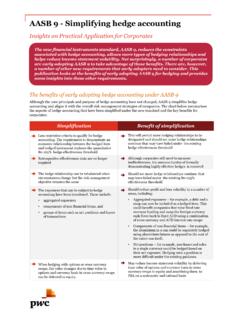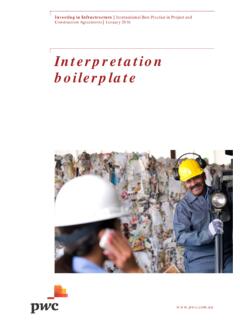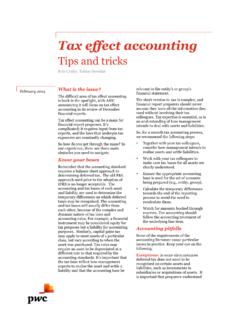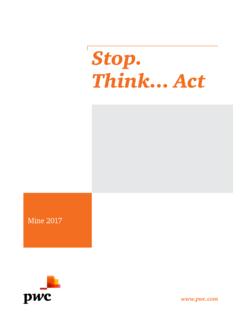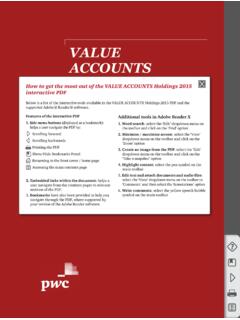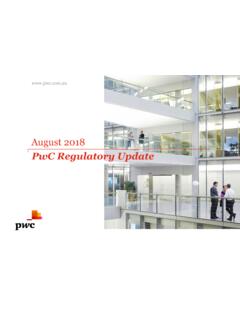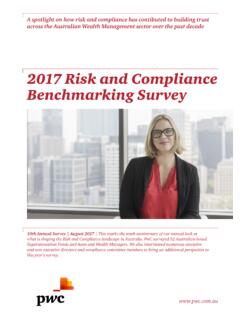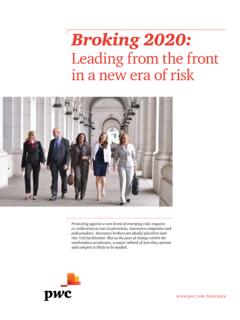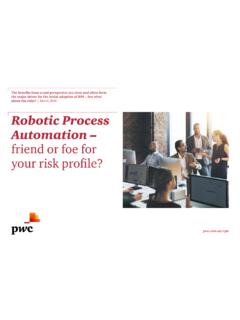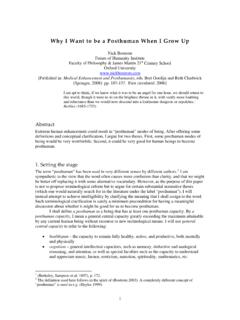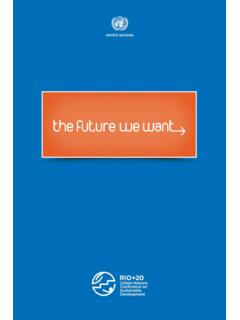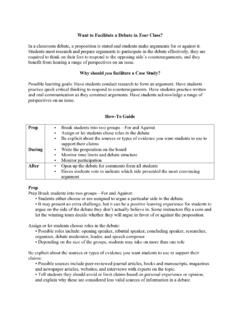Transcription of The Future of Work
1 The Future of Work What workers want : Winning the war for talent Introduction 03. Contents 01. Undervalued and underestimated 05. 02. PwC's Employee Preference Index 06. 03. What workers 07. 04. Striking the right balance 12. 05. One size fits nobody 15. 06. Attraction trumps retention 18. Introduction Australia has just experienced the lowest employee turnover since the Australian To protect themselves from the full Bureau of Statistics started tracking labour mobility in 1972: ABS data shows that just force of The Great Resignation, and of Australian workers changed jobs attract the right skills, organisations in the year to February 2021. Meanwhile, must identify what their workers border closures coupled with a reluctance really want and reimagine their for workers to change jobs in an uncertain Employee Value Proposition (EVP). market has meant we also have a record to deliver on these expectations.
2 High number of job vacancies that just However, our research indicates can't get filled. that leaders' perspectives on what employees value most differ from Because while there are large numbers what workers really want - leaving of workers on the move, which would historically signal a healthy economy, our organisations in a potentially new research study of 1,800 Australian dangerous situation. workers found that 38% are looking at Its ability to attract and retain key leaving their current employer in the next talent - and minimise fallout from 12 months. That's why Australian workers The Great Resignation - will be will soon be on the move in much larger numbers than we've seen in recent times: compromised if the EVP doesn't The Great Resignation. provide what workers want . Some commentators have said this intent has been created by a sense of restlessness, or looking to regain control, after a significant period in lockdown.
3 Sociologists suggest that people have been particularly introspective as a result of the pandemic, which can often lead to job and career changes- and others Some good news, and a believe it has been building up in the proven solution background for some time, as people have been reluctant to change employers in an The good news is that our research unstable market. also reveals a significant portion of the workforce has a strong intent to stay It's likely to be a combination of all those (55%) So this is a unique point in time factors - but it doesn't alter the reality for employers and employees alike. It that Australian organisations are about to represents a massive opportunity for those see people walking out the door. And it's organisations that redesign their EVP to adding to the impression that the balance 38%. position themselves as an employer of of power is shifting from the employer choice, retain loyal staff, and attract top to the employee.
4 Because in the war for talent. But organisations failing to do so talent, it's the worker who has the better will compromise their ability to drive post- of workers bargaining position. pandemic recovery and growth. The time plan to leave to act is now. their current employer during the next year What workers want | The Future of Work 3. People, places and positions Our Future of Work, What Workers want research survey sample was comprised of: 1,800 Australian workers 45% 55%. Female Male 5% 36% 37% 22%. Gen Z Millennials Gen X Baby Boomers 35%. New South Wales 74% 26%. 28% 37% City Regional Victoria other states 15% 32%. frontline worker 49%. office worker senior executives 40% 7%. entry-level worker 13%. other middle managers/. supervisors 49% 16%. 12 34. 45% identified as having carers work multiple jobs non-management commitments 4 The Future of Work | What workers want What workers want | The Future of Work 4.
5 Undervalued and underestimated An EVP is just a buzzword to some. But in reality, it is so much more. It encapsulates everything from what an organisation uses to attract and retain talent, through to how someone describes the experience of working for a company to their friends. It's the balance of tangible and intangible benefits, representing why someone would choose to work at one organisation over another. An EVP is complex and highly nuanced. There are objective elements, such as the terms of a leave policy, and subjective ones like the experience of working for a particular leader. And so the employee experience will differ across industries, organisations, and even across functions and teams within a business. It will vary depending on the individual, as their personal circumstances and priorities evolve. The EVP is not constant either, with a quarter of workers saying the reasons they join an organisation and the reasons they stay are not always the same.
6 For example, someone might join for the pay but stay because of the culture. Or join because of a promotion but stay because of their networks and relationships. 25%. of workers say the reason they join an organisation isn't always why they stay What workers want | The Future of Work 5. PwC's Employee Preference Index Although an EVP is complex in nature, it doesn't need to be complicated. We have developed an employee preference index with seven levers to help leaders organise their thinking and drive effective change: Remuneration Workspaces and Ways of working and reward places The salary paid to employees, The working environment in How work gets done, including the other financial incentives the office or at home, including flexibility and autonomy afforded to including bonuses, profit-sharing physical design and workplace workers, the ability to collaborate, schemes and pensions, as well perks like subsidised food and opportunities for travel, the use as packaged subsidies such as drinks, office equipment.
7 Of technology, and the manner phones and cars. in which these are embedded in organisational policies. Wellbeing Career development Maintaining the physical and This includes a diverse range of mental health of workers through factors from learning and upskilling dedicated wellbeing programmes programmes, study assistance and and policies, with a particular support, through to the quality of focus on the work-life balance of leadership, access to feedback and the role. coaching, career pathways, and opportunities for secondments. Underpinning each of these seven levers are a series of more specific initiatives. An overview of these initiatives and Experience Brand their alignment to the seven levers is provided as an attachment. How people experience their role, The reputation of and affiliation team, and organisation including with the values and the prestige the culture, relationships, diversity, of the brand.
8 This includes the team spirit and the energy of co- commitment towards social workers. responsibility and shared value. What workers want | The Future of Work 6. What workers The needs and expectations of workers are incredibly diverse. To help understand what these are, we asked workers to force rank their preferences based on what they value most from an employer. This is what they told us: Rank Lever Preference weighting: Top 1 ranking Initiatives to consider Fixed pay Bonuses and profit share schemes 1 Remuneration 25% Superannuation Discounts and lifestyle benefits (. childcare, car parking, and reward discounted finance, product discounts etc). Mental health support Wellness benefits such as gym membership 22%. Lifestyle benefit 2 Work-life balance Health and wellbeing Wellbeing Financial support Through training and courses Culture Diversity and inclusion 3. Experience 16% Support and relationships Networks Formal and informal Team spirit and energy Co-workers What workers want | The Future of Work 7.
9 Rank Lever Preference weighting: Top 1 ranking Initiatives to consider Technological enablement Ensuring set up from day one 12%. Flexibility 4 Travel ( interstate/overseas). Ways of working Autonomy Collaboration Rank Learning and upskilling Formal and informal Quality of leadership 5 Career 11% Access to mentoring and coaching Career pathways and opportunities /. secondments development On-the-job learning Prestige/affiliation 6. Brand 8% ESG and social responsibility Volunteering Values alignment What we stand for The physical office design Workplace perks ( free coffee, subsidised food etc.). 7. Workspaces 5% Location Work from home Hybrid work environment and places Rich technology set up 22%. of employees value support of their wellbeing above all other factors What workers want | The Future of Work 8. What workers want .. and what leaders think they want There is a sizable gap between what workers want and what senior leaders think their people want .
10 When it comes to their existing workforce, top executives are extremely confident about worker sentiment; not one reported their people were even somewhat disengaged. This is consistent with the view of employees, with our study finding that employee engagement across Australian organisations was high (78%). There is a stark finding in this for leaders when we overlay this sentiment with the high proportion of employees looking to leave their employer. Top executives may be comforted by a false sense of security. In the current climate we can't equate employee engagement with an intent to stay. What workers want | The Future of Work 9. Here's the expectation gap in black and white. The table below shows us where senior leaders believed their workers ranked EVP preferences, versus the Leaders beliefs Employees ranking reality from those workers. Values alignment between worker and organisation 1st 16th On-the-job learning 2nd 13th Pay (incl.)
